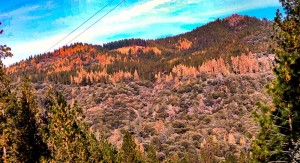It’s looking pretty gloomy in the coastal and mountain forests around the state. As the New York Times reports, since 2010, an estimated 66 million trees have died, leading to what may likely be some permanent changes to these ecosystems, as they shift from forest to grass and shrub lands:
Scientists say rarely is one culprit to blame for the escalation in the state’s tree deaths, and the resulting fire hazard. Rather, destruction on such a broad scale is nearly always the result of a complex convergence of threats to forest ecosystems.
Chief among them is a severe, sustained drought in the Sierra Nevada that is stressing trees and disabling their natural defenses. Climate change is raising temperatures, making for warmer winters. No longer kept in check by winter’s freeze, bark beetle populations are growing. Separately, a nonnative, potent plant pathogen is thriving in the moist areas of the North Coast, introduced to California soil by global trade. Opportunistic fungi are standing by, ready to finish the kill.
 It’s all exacerbated by a legacy of terrible forest management over the past century-and-a-half or so, which I’ve witnessed firsthand in places like Lake Tahoe.
It’s all exacerbated by a legacy of terrible forest management over the past century-and-a-half or so, which I’ve witnessed firsthand in places like Lake Tahoe.
In the short term, we should clear these trees out and use them as low-carbon energy sources. But in the long term, we need to aggressively thin the forests and go back to traditional land management practices of regular, controlled burns.
It’s our best hope against the ecological onslaught facing these beautiful lands.


